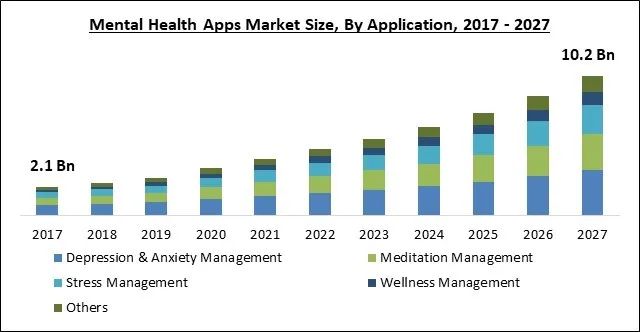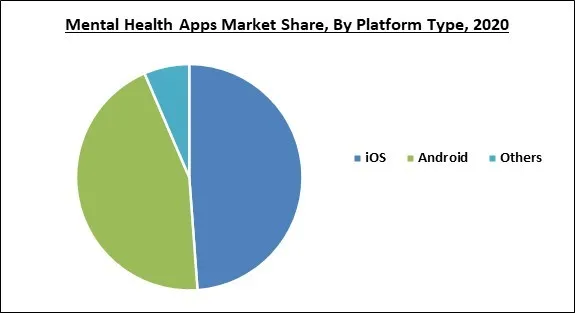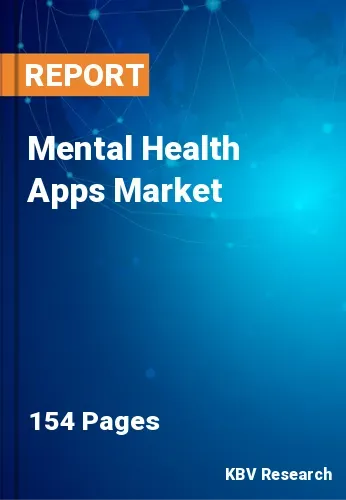The Global Mental Health Apps Market size is expected to reach $10.2 billion by 2027, rising at a market growth of 16.3% CAGR during the forecast period.
Apps for mental health are tools that can be used on a smartphone or other mobile device. These apps are designed to help users become more self-aware by allowing them to control their mood, retain good habits while breaking bad ones, and cultivate positive thinking. Mood disorders, personality disorders, trauma-related disorders, psychotic disorders, anxiety disorders, eating disorders, and substance misuse disorders are among the severe mental disorders targeted by mental health applications.
The market is rising because individuals become more aware of the significance of mental health and as a result of the debut of several mental wellness applications. The advent of significant health campaigns such as Campaign Against Living Miserably (CALM) to promote awareness about mental health, as well as the rising use of connected gadgets among the youthful population, are driving up market value.
Furthermore, poor work-life balance and eating habits, social isolation, hectic schedules, and relationship issues are all key factors that are raising the incidence of mental illness among people all over the world, particularly in developed and emerging nations. Moreover, it is expected that increased awareness among people in developing economies, as well as the creation of updated and advanced featured applications, would provide prospective prospects over the forecast period.
Therapy applications were already gaining traction among people dealing with issues ranging from stress to serious mental disease when the COVID-19 outbreak struck. When offices turned virtual, they carved out a niche for themselves in the mental health industry. While certain apps, such as Talkspace and Betterhelp, pair you with a certified therapist, a large chunk of the industry has gone completely humanless. Friendly chatbots provide cognitive behavioural therapy; mood trackers remind bipolar disorder patients to keep track of their mood; and apps for treating post-traumatic stress disorder claim to assist people get over acute bouts by guiding them through deep breathing exercises.

The COVID-19 pandemic resulted in a spike in mental health app downloads as well as greater awareness of mental health as a serious concern. As a result, the digital health and mobile health sectors have shown significant growth potential. According to ORCHA (Organization for the Review of Care and Health Applications) data, mental health app downloads in the United Kingdom climbed by about 200 percent from summer 2019 to summer 2020.
Due to the many advantages offered by these apps in treating mental health conditions like as stress, sadness, and anxiety, the market for mental health apps saw a rise in adoption during the COVID-19 pandemic. As per Sensor Tower statistics, the top mental wellness apps saw a combined download increase of about 2 million in April 2020 compared to January.
For persons suffering from depression, there are literally thousands of apps available. Some are based on exchanging messages or making phone calls with doctors, while others provide recommendations, self-guided mood training programmes, and gamification components. MoodTools, an anti-depression app, treats depression carefully and has a suicide safety plan in place in the event of a crisis. There are additional apps for treating diseases like schizophrenia and psychoses, in addition to depression apps. Doctors, on the other hand, argue that apps for people with psychological illnesses are best used as a supplement to regular therapy; unlike apps for mentally healthy people, applications for persons with psychological disorders must include doctors.
People's or society's stress levels are rising as a result of causes such as substance addiction, increased mental health awareness in recent years, and fewer social connections. In addition, over time, the use of advanced linked technologies such as physician-recommended mental health apps, wearables, and self-assessment awareness gadgets has grown. As a result, demand for mental health apps is predicted to increase in recent years. Psychotherapists, other doctors, psychiatrists, and clinical psychologists can use mental apps to examine and monitor their patients' mental health. As a result, the market for mental health applications is fueled by the adoption of such apps by experts.
Although there is research on using mobile apps in conjunction with therapy, there is little research about how these apps are developed, with one exception: if the apps are produced by the federal government, such as the Substance Abuse and Mental Health Administration (SAMHSA) or the US Department of Veteran's Affairs (VA)/Department of Defense (DOD), they usually include app development information. There are two types of mental health apps for mobile devices: passive and active. Active apps necessitate direct patient input, like the completion of mood logs, self-symptom ratings, and the recording of personal experiences. Without the patient or provider's knowledge, passive apps can access information and collect data using smartphone functions like GPS. Though it may be advantageous, some people may object to the possible invasion of privacy that such data collection entails.

Based on Application, the market is segmented into Depression & Anxiety Management, Meditation Management, Stress Management, Wellness Management, and Others. The stress management segment witnessed a promising revenue share in the mental health apps market in 2020. The increasing prevalence of stress and related diseases, as well as the growing usage of applications that aid in stress reduction and management, are driving the segment's rise over the forecast period.
Based on Platform Type, the market is segmented into iOS, Android, and Others. In 2020, the iOS segment procured the highest revenue share in the mental health apps market. The growing acceptance of iOS among customers can be linked to the rise of the iOS category. The market share of iOS in the United Kingdom climbed from 47 percent in Q3 2020 to 51.6 percent in Q3 2021, according to data published by Business of Apps in 2021. As a result, such examples show that the segment will grow in the next years.
| Report Attribute | Details |
|---|---|
| Market size value in 2020 | USD 3.4 Billion |
| Market size forecast in 2027 | USD 10.2 Billion |
| Base Year | 2020 |
| Historical Period | 2017 to 2019 |
| Forecast Period | 2021 to 2027 |
| Revenue Growth Rate | CAGR of 16.3% from 2021 to 2027 |
| Number of Pages | 154 |
| Number of Tables | 279 |
| Report coverage | Market Trends, Revenue Estimation and Forecast, Segmentation Analysis, Regional and Country Breakdown, Companies Strategic Developments, Company Profiling |
| Segments covered | Platform Type, Application, Region |
| Country scope | US, Canada, Mexico, Germany, UK, France, Russia, Spain, Italy, China, Japan, India, South Korea, Singapore, Malaysia, Brazil, Argentina, UAE, Saudi Arabia, South Africa, Nigeria |
| Growth Drivers |
|
| Restraints |
|
Based on Regions, the market is segmented into North America, Europe, Asia Pacific, and Latin America, Middle East & Africa. North America emerged as the leading region in the mental health apps market with the maximum revenue share in 2020. The market is being fueled by prominent factors such as the increasing adoption of smartphones, advancements in coverage networks, and increased penetration of the internet and social media. Smartphone usage in the North American region was around 80% in 2020, according to the GSMA's The Mobile Economy Report 2021, and is anticipated to reach 85 percent by 2025.
Free Valuable Insights: Global Mental Health Apps Market size to reach USD 10.2 Billion by 2027
The market research report covers the analysis of key stake holders of the market. Key companies profiled in the report include Calm.com, Inc., MoodMission Pty. Ltd., Sanvello Health, Inc. (UnitedHealth Group Incorporated), Headspace, Inc., Flow Neuroscience AB, Youper, Inc., Urban Massage Ltd., Happify, Inc., and SilverCloud Health, Inc. (American Well Corporation).
By Application
By Platform Type
By Geography


The global mental health apps market size is expected to reach $10.2 billion by 2027.
High inclination towards virtual therapies are driving the market in coming years, however, privacy and research concerns limited the growth of the market.
Calm.com, Inc., MoodMission Pty. Ltd., Sanvello Health, Inc. (UnitedHealth Group Incorporated), Headspace, Inc., Flow Neuroscience AB, Youper, Inc., Urban Massage Ltd., Happify, Inc., and SilverCloud Health, Inc. (American Well Corporation).
Yes, COVID-19 pandemic resulted in a spike in mental health app downloads as well as greater awareness of mental health as a serious concern. Due to the many advantages offered by these apps in treating mental health conditions like as stress, sadness, and anxiety, the market for mental health apps saw a rise in adoption.
The Depression & Anxiety Management segment acquired maximum revenue share in the Global Mental Health Apps Market by Application in 2020, thereby, achieving a market value of $3.2 billion by 2027.
The North America is fastest growing region in the Global Mental Health Apps Market by Region in 2020, and would continue to be a dominant market till 2027.
Our team of dedicated experts can provide you with attractive expansion opportunities for your business.

